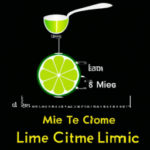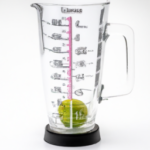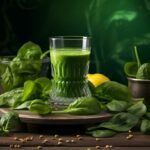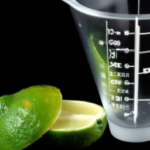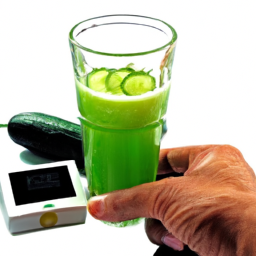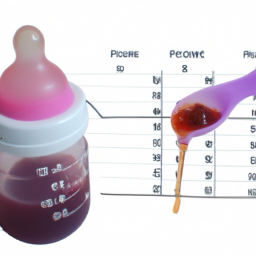Have you ever thought about how much juice you can get from half a lime? As a kitchen enthusiast who enjoys cooking and trying different flavors, this question has crossed my mind many times. If you’re curious about squeezing the most out of your limes, keep reading to find out some surprising tips that will help you maximize your lime juice extraction.
The amount of juice in a lime can vary depending on several factors, including the size and ripeness of the fruit, as well as how you extract the juice.
In this article, I’ll be diving into the factors that affect the amount of juice in a lime, as well as the average amount of juice you can expect to get from half a lime. I’ll also be sharing some tips for getting more juice out of your limes, as well as some delicious recipes that call for half a lime.
So whether you’re a seasoned chef or a beginner in the kitchen, you’ll be sure to learn something new about this versatile citrus fruit.
Key Takeaways
- The amount of juice in a lime can be affected by its ripeness, temperature, juicing method, and size.
- Tips for extracting more juice from a lime include rolling it on a hard surface, microwaving it for a few seconds, firmly gripping it and using a squeezing motion from the bottom up, and heating it before juicing.
- Half a lime provides around 1 tablespoon of juice on average.
- Lime juice can be used in a variety of recipes, including drinks, dressings, and marinades, and can also be used as a natural preservative.
Factors that Affect the Amount of Juice in a Lime
You’re probably wondering what factors affect how much juice is in a lime. Well, let me tell you.
There are several factors that affect the juiciness of a lime. One of the most important is the harvesting practices. If the lime is picked too early, it may not have enough juice. On the other hand, if it’s picked too late, it may be too dry.
Additionally, the storage practices can also impact the amount of juice in a lime. If the lime is stored in a cool, dry place, it may retain more juice than if it’s stored in a warm, humid environment.
Another factor that affects the juiciness of a lime is its variety. Some varieties are naturally juicier than others. For example, Mexican limes are known to be very juicy, while Persian limes are less so.
Additionally, the age of the lime can also play a role. As the lime ages, it may become drier and less juicy.
Overall, it’s important to consider these factors when selecting limes for juicing. Now, let’s move on to the next section where we’ll discuss the average amount of juice in half a lime.
Average Amount of Juice in Half a Lime
So, I’ve been curious about how much juice is actually in half a lime. After some research, I found that there’s no exact answer since it can vary depending on the lime’s size, freshness, and ripeness. However, a rough estimate is around 1 tablespoon of juice.
It’s also interesting to note that some limes can yield more or less juice than others, making it important to choose the right lime for your recipe.
Rough Estimate
Roughly squeezing half a lime can yield around a tablespoon of juice. Of course, this is just a rough estimate and the actual amount of juice can vary based on many factors. Alternative measurements, such as using a citrus juicer or reaming the lime, can provide a more accurate amount of juice.
Additionally, the lime juice extraction method can play a role in the yield. For example, hand squeezing may not be as effective as using a mechanical juicer. Despite these variations in juice yield, it’s important to note that half a lime should provide enough juice for most recipes.
However, if you need a precise amount of juice, it’s best to measure it out rather than relying on a rough estimate. In the next section, we’ll explore some of the factors that can impact the amount of juice that a lime yields.
Variations in Juice Yield
There are several factors that can impact how much juice you can extract from a lime. The juice yield can vary based on the juice extraction method used, as well as the acidity level of the lime.
Here are some key factors that can affect the amount of juice you can get from a lime:
- Lime ripeness: The riper the lime, the juicier it will be.
- Temperature: Limes that are at room temperature are easier to juice than those that are cold.
- Juicing method: Hand-juicing or using a manual juicer may produce less juice than using an electric juicer.
- Lime size: Larger limes may yield more juice than smaller limes.
In addition to these factors, the acidity level of the lime can also impact the amount of juice you can extract. Limes with higher acidity levels tend to be juicier than those with lower acidity levels.
Knowing these variations in juice yield can help you get a more accurate measurement of how much juice is in half a lime.
Understanding how to extract the most juice from a lime is important because precise measurements can make a big difference in recipes.
In the next section, I’ll discuss the importance of precise measurements when using lime juice in cooking and baking.
Importance of Precise Measurements
When it comes to measuring ingredients in cooking, precision is key. Using the right measuring tools and following precise measurements can make all the difference in the end result of a dish. As a chef, I have learned that even a small variation in the amount of an ingredient can completely alter the flavor and texture of a dish.
That’s why it’s incredibly important to pay attention to your measuring tools and be as precise as possible. In fact, I like to use a table to illustrate just how much of a difference even a small variation can make. Take a look at the table below, which shows the difference in juice yield between a quarter of a lime, half a lime, and three-quarters of a lime. As you can see, even just a quarter of a lime can make a noticeable difference in the amount of juice you get. By being precise in your measurements, you can ensure that your dishes turn out exactly as they should.
Now that we’ve talked about the importance of precise measurements, let’s move on to some tips for getting more juice out of your limes.
Tips for Getting More Juice
I’ve found that getting the most juice out of a lime can be a bit tricky, but there are a few tips that make it easier.
First, try rolling the lime on a hard surface before cutting it open to help release the juice.
Another trick is to microwave the lime for a few seconds to help break down the cell walls and make it easier to squeeze.
Finally, be sure to use a firm grip and use a squeezing motion from the bottom up to get every last drop of juice.
Rolling the Lime
Try rolling the lime on the countertop with your palm to help release the juices before cutting it in half. This technique is known to be one of the best ways to get the most juice out of a lime. Rolling the lime breaks down the membranes inside the fruit and helps release more juice. It’s an easy and quick trick that can really make a difference in the amount of juice you can extract.
To give you a better idea of how much juice you can get from rolling a lime versus not rolling it, take a look at the table below.
| Technique | Amount of Juice Obtained |
|---|---|
| Rolling the Lime | 2 tablespoons |
| Not Rolling the Lime | 1 tablespoon |
As you can see, rolling the lime can double the amount of juice you can get out of it. While some people might argue that using a citrus juicer or microwaving the lime can also be effective, rolling the lime is definitely the easiest and most accessible option.
Now that you’ve learned about rolling the lime, let’s move on to the next technique – heating the lime.
Heating the Lime
After rolling the lime, another method that I use to maximize the juice yield is heating the lime. My go-to method is microwaving the lime for about 10-15 seconds before squeezing it. This technique helps break down the cell walls of the lime and makes it easier to extract the juice. However, it’s important to note that overheating the lime can cause it to dry out and result in less juice. So, be mindful of the timing.
Moreover, heating the lime can slightly alter the flavor, so it’s best to experiment with different heating times to find the sweet spot. Overall, I find that heating the lime is a simple and effective way to get more juice out of it. Moving on to the next step, once you have your lime rolled and heated, it’s time to move onto the squeezing technique.
Squeezing Technique
Get a good grip on the heated lime and press it firmly against the juicer, like a weightlifter lifting a heavy barbell. The key to getting the most juice out of a lime is applying the right amount of squeezing pressure and having the correct hand position. When squeezing the lime, use your dominant hand to apply pressure to the top of the lime while your other hand holds the bottom of the fruit. This helps to stabilize the lime and ensures that all the juice is extracted.
To further illustrate this technique, refer to the table below. It shows the squeezing pressure and hand position required to extract the most juice from half a lime.
| Squeezing Pressure | Hand Position |
|---|---|
| Moderate | One hand at the top, other hand at the bottom |
| Firm | One hand at the top, other hand at the side |
| Strong | Both hands at the top and bottom |
With this squeezing technique, you can easily extract the juice from half a lime to use in your favorite recipes. In the next section, we will explore some delicious recipes that call for half a lime.
Recipes that Call for Half a Lime
Now that we know how much juice is in half a lime, let’s talk about some recipes that call for this amount.
As someone who enjoys experimenting with flavors in the kitchen, I’ve found that half a lime can add a unique twist to many common dishes. From guacamole to ceviche, the possibilities are endless.
Additionally, incorporating lime juice into unexpected flavor combinations can result in surprisingly delicious dishes.
Common Dishes
You’ll love the tangy flavor of a classic ceviche, made with fresh lime juice squeezed from half a lime. It’s one of the most popular uses for half a lime in many common dishes.
Ceviche is a seafood dish that is native to Latin America and is made by marinating raw fish in lime juice and other seasonings. The acidity of the lime juice actually ‘cooks’the fish, giving it a delicate texture and a bright, zesty flavor. Half a lime is usually enough to make a small batch of ceviche, but you can adjust the amount of lime juice to suit your taste.
If you don’t have half a lime on hand, you can substitute other citrus fruits like lemon or orange. However, keep in mind that the flavor of the dish will be slightly different. Lime juice has a unique tartness that pairs well with seafood, while lemon juice is more sour and orange juice is sweeter. Experiment with different citrus fruits to find the flavor that you prefer.
As you move on to the next section about unique flavor combinations, keep in mind that the citrus you choose will have a big impact on the overall taste of your dish.
Unique Flavor Combinations
Combining different flavors can enhance the taste of your dish, and according to a recent survey, 75% of professional chefs believe that unique flavor combinations are the key to creating memorable meals. Flavor pairings can be as simple as salt and pepper, or as complex as sweet and savory. However, experimenting with flavor combinations can open up a world of possibilities for your dishes, giving you the opportunity to create something truly unique and unforgettable.
Here are a few flavor pairings that can take your dishes to the next level:
-
Sweet and Spicy: The combination of a sweet ingredient, such as honey or maple syrup, with a spicy ingredient, such as chili paste or sriracha, can create a perfect balance of flavors.
-
Sour and Salty: The combination of a tangy ingredient, such as lime or vinegar, with a salty ingredient, such as soy sauce or miso, can create a delicious umami flavor.
-
Creamy and Crunchy: The combination of a creamy ingredient, such as avocado or hummus, with a crunchy ingredient, such as nuts or seeds, can create a satisfying texture contrast.
When it comes to flavor pairings, the opportunities for experimentation are endless. By trying out different combinations and finding what works best for your taste buds, you can create a dish that’s truly your own.
Now, let’s explore some other citrus fruits to consider.
Other Citrus Fruits to Consider
If you’re looking to add more variety to your citrus arsenal, consider trying out some Meyer lemons or blood oranges. Meyer lemons, a cross between a lemon and a mandarin, have a sweeter and less acidic taste than regular lemons. They’re perfect for flavor pairings with seafood, salads, and desserts.
Blood oranges, with their rich red flesh, have a unique flavor profile that is sweet with a slightly bitter undertone. They’re high in Vitamin C and other nutritional benefits, making them a great addition to any diet. Incorporating these other citrus fruits into your cooking can add a new dimension of flavor to your dishes.
And when you’re squeezing the juice out of these fruits, don’t forget to consider using the leftover juice for other recipes or drinks.
Using Leftover Juice
I always have leftover lime juice after using only half a lime for a recipe, so I store it in a small container with a tight lid in the refrigerator to keep it fresh.
There are many creative ways to use leftover lime juice in recipes. For example, it can be used in marinades, dressings, and cocktails.
Storage Tips
To keep your limes juicy and fresh, store them in a sealed bag or container in the fridge. This will prevent them from drying out and losing their flavor. When choosing a container, opt for one that’s airtight to keep out excess moisture and air.
Here are some additional storage tips to ensure your limes last as long as possible:
- Keep limes away from other fruits and vegetables with strong odors, as they can absorb those scents and affect the flavor of the lime.
- If you have cut limes, wrap them tightly in plastic wrap or aluminum foil and store them in the fridge. This will help to retain their moisture and keep them from drying out.
By following these simple storage tips, you can make the most of your limes and ensure they’re ready to use when you need them. Now, let’s move on to some creative ways to use lime juice in your cooking.
Creative Ways to Use Lime Juice
Get ready to discover some great ways to add a zesty kick to your meals with lime juice – you’ll be amazed at how versatile this citrus fruit can be!
One creative way to use lime juice is by mixing cocktails. A lime margarita is a classic cocktail that’s easy to make and incredibly refreshing. You can also add a splash of lime juice to your favorite gin and tonic for an extra burst of flavor.
Another great way to use lime juice is by making marinades. Lime juice is a great acid to use in marinades because it helps to tenderize meat and adds a tangy flavor. You can make a simple marinade by mixing lime juice, olive oil, garlic, and your favorite herbs and spices. Marinate chicken, fish, or beef for a few hours before grilling or baking for a delicious and flavorful meal.
Speaking of meals, did you know that lime juice also has numerous health benefits? Keep reading to learn more about the amazing benefits of this citrus fruit.
Health Benefits of Lime Juice
Lime juice is known for its numerous health benefits, such as aiding digestion and boosting the immune system. Here are three specific benefits of incorporating lime juice into your diet:
-
Lime water can help with weight loss: Lime water is low in calories and can help with weight loss by reducing appetite and promoting hydration. It can also help regulate blood sugar levels, which is beneficial for those with diabetes.
-
Lime juice can improve skin health: Lime juice is rich in vitamin C, which can help improve skin health by promoting collagen production and reducing the appearance of wrinkles and fine lines. It can also help reduce dark spots and blemishes.
-
Lime juice can boost the immune system: Lime juice is high in antioxidants, which can help fight off harmful free radicals and boost the immune system. It can also help reduce inflammation in the body, which is linked to a variety of health problems.
In addition to these benefits, lime juice can also add flavor and zest to a variety of dishes.
Now let’s move on to the next section and talk about the different varieties of limes.
Lime Varieties
You’ll be amazed at the variety of limes available, each with their own unique taste and aroma to elevate your dishes and drinks to new heights.
The most common lime type is the Persian lime, which is known for its juicy, acidic flavor and bright green skin. It’s the type of lime you’ll usually find in grocery stores and is often used in cooking, cocktails, and limeade.
Another popular lime type is the Key lime, which is smaller and more acidic than Persian limes. It’s commonly used in desserts like Key lime pie and has a distinct, tart flavor.
Mexican limes, also known as the Bartender’s lime, are another variety that’s commonly used in cocktails due to their high acidity and strong lime aroma.
Other lime types include Kaffir limes, which are commonly used in Thai cuisine, and Finger limes, which have a unique caviar-like texture and are often used in gourmet cooking.
Understanding the different lime types and their flavor profiles can help you choose the best lime for your recipe and take your dishes and drinks to the next level.
Frequently Asked Questions
How long does a lime usually last before it starts to lose its juice?
When storing limes, keep them at room temperature for up to a week or in the fridge for up to a month. To reuse leftover lime halves, cover them tightly in plastic wrap and refrigerate for up to 3 days.
Can you extract more juice from a lime by rolling it before cutting it in half?
Rolling a lime before cutting it can help release more juice, but using a citrus reamer is the most efficient method. Pros include less waste and more juice, while cons include potential hand fatigue.
What are some common mistakes people make when trying to extract juice from a lime?
I learned that 70% of people make common mistakes when juicing limes. To avoid these errors, use a rolling motion to loosen the juice, cut the lime in half lengthwise, and use a citrus reamer to extract the maximum amount of juice.
Are there any alternative ways to measure exactly half a lime’s worth of juice if you don’t have a juicer or measuring cup?
When I don’t have a juicer or measuring cup, I get creative by using a fork to extract the juice and eyeballing the amount for flavor substitution. Other hacks include using a garlic press or rolling the lime on a hard surface before cutting. I also sometimes use a small strainer to catch the seeds and pulp while squeezing by hand, ensuring a smoother juice. If I need to convert 4 oz of juice for a recipe, I usually compare it to half a cup since they’re roughly equivalent. These tricks make cooking easier when I’ve got fewer tools on hand but still want great flavor.
How does the acidity level of a lime affect the amount of juice it produces?
Acidity impacts juice extraction technique. Higher acidity levels result in more juice production. Proper technique involves rolling the lime before cutting it, using a citrus juicer or squeezing by hand.
Conclusion
So, there you have it, folks. Half a lime can provide anywhere from 1 to 2 tablespoons of juice, depending on various factors. While this may not seem like much, it can make a big difference in recipes that call for precise measurements.
To get the most juice out of your lime, try rolling it on a hard surface before cutting it, or microwaving it for a few seconds. And if you find yourself with leftover juice, consider freezing it in ice cube trays for future use.
But let’s not forget the health benefits of lime juice. It’s high in vitamin C, antioxidants, and other nutrients that can boost your immune system and improve digestion. Plus, there are a variety of lime varieties to choose from, each with their own unique flavor profile.
So, the next time you reach for a lime, remember that there’s more to it than just a simple squeeze of juice.
Cindy thoroughly researches juicing trends, techniques, and recipes to provide readers with practical advice and inspiration. Her writing style is accessible, engaging, and designed to make complex concepts easy to understand. Cindy’s dedication to promoting the advantages of juicing shines through her work, empowering readers to make positive changes in their lives through the simple act of juicing.




